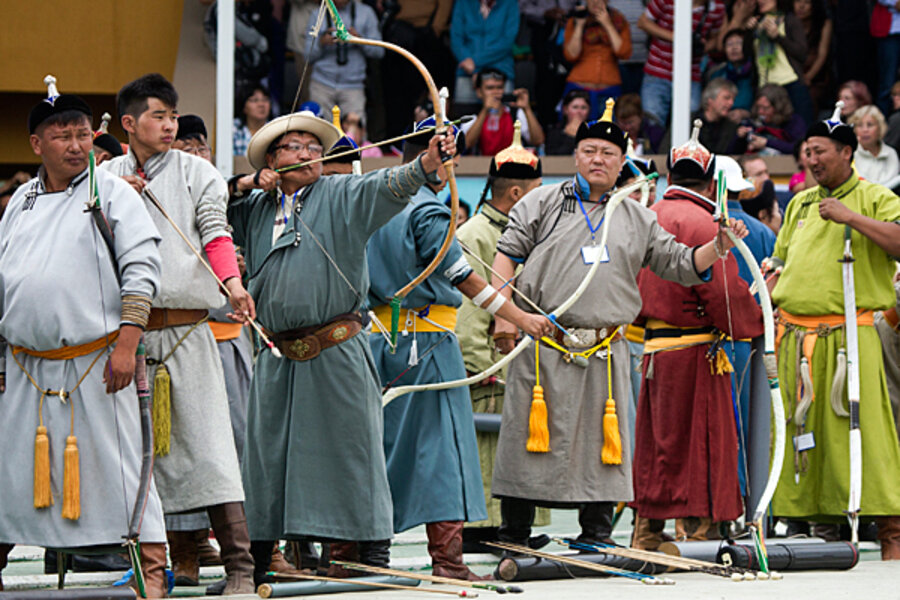How to toss an anklebone and shoot an arrow like a Mongolian
Loading...
| Ulaanbaatar, Mongolia
The London Olympics are all very well, but frankly, what is a sporting extravaganza really worth if it doesn’t include anklebone tossing?
In Mongolia, anklebone tossing (more on this later) is one of the steppe sports that nomads here have practiced since time immemorial; this week, in an annual three-day pageant of almost impossibly picturesque tradition, Mongolians are celebrating their unique culture.
Ponies have thundered across the rolling grasslands in races lasting nearly an hour; archers dressed in flowing robes held by bright silken sashes have aimed their arrows at absurdly small targets from 80 paces, and hit them; hulking wrestlers have grappled with each other, locked in combat like bison, before thousands of spectators in the national stadium; and, of course, anklebone tossers have tossed anklebones.
Naadam, which means “the games,” is a festival that dates back to 1206, the year when Ghengis Khan founded and named his empire, and took his own noble name for the first time, according to Jack Weatherford, a historian of Mongolia’s imperial past.
The earliest known inscription in the Mongolian language commemorates the exploit of an archer at the games held in 1224 or 1225 to celebrate the success of Genghis Khan’s campaign in Central Asia. The bowman shot an arrow more than 350 yards, the stone recounts, setting a record that has not been beaten for 788 years.
A century later, Kublai Khan presided over Naadams from his stately pleasure domes in what is now northern China. “These games have gone on forever,” says Professor Weatherford. “When Mongolians hold a celebration, this is what they do.”
The pro-Soviet puppet regime that ruled Mongolia between 1921 and 1990 turned Naadam into a celebration of the socialist revolution, which is why it starts on July 11, the anniversary of the revolution. But since the collapse of the Soviet Union and the emergence of an independent Mongolia, the games have become more of a celebration of Genghis Khan’s “Great Mongolian Empire.”
Genghis Khan’s skills as an anklebone tosser are shrouded in the mists of time. But the accuracy of today’s champions is startling.
How to toss an anklebone
Dressed traditionally in square felt caps with a decorative spike, richly decorated robes and calf-high riding boots, they sit impassively on low stools, deep in concentration, and use their middle finger to flick a small, wedge shaped piece of animal anklebone from a polished wooden launchpad at two other pieces of bone – scarcely larger than dice – sitting on a platform five paces away.
Competitors send the target bones skittering away with extraordinary regularity.
Archers, too, display astonishing precision as they shoot at tin can-like cylinders of woven leather lined up on the ground, recalling the unmatched skill of Ghengis Khan’s cavalrymen at shooting from the back of their galloping horses.
The most popular sport is wrestling; two days of knockout competition – one fall and you’ve lost – whittle 512 starting wrestlers down to a single victor who instantly becomes a national hero to those who have packed the stadium and to everyone else in the country who has been glued to TV coverage.
The rules are simple but the procedures of the nine-round competition are complex, and Mongolian passions are easily stoked by the sight of two elephantine men leaning into each other head to head, waiting for the right moment to push, pull, lift, or trip their opponent in a sudden burst of activity.
When victory comes, the winner celebrates with a slow-motion lumbering lope, holding his arms outstretched, in the “eagle dance,” and his opponent must lower his head to pass beneath the victor’s arm.
'The difference between driving a Russian jeep and a Porsche'
The sport most symbolic of Mongolians’ nomadic past and present, though, is horse racing.
It bears little resemblance to racing in the United States or Europe: There is no track, just a vast expanse of rolling steppe 30 miles west of the capital, Ulaanbaatar, across which horse tamers pitch their “gers” (circular nomadic tents like yurts) in clumps.
Hundreds of horses run in each race, ridden bareback by boy jockeys, and sometimes by girls. They gather at the finish line, and then walk or trot the 16 miles to the start, turn around and race back, their hooves stirring up red dust clouds that can be seen from miles away.
The low-shouldered, tough little Mongolian ponies don’t look much like Western thoroughbred horses, either. Trainer Bat-Ulzii, a herder who had driven 300 miles to take part in this year’s Naadam, says that the foreign horses he has seen in films “look fancier and more elegant than our horses. But they don’t seem to be sturdy over long distances.”
Darima, a stylish young woman who grew up here on horseback before joining Goldman Sachs in London and riding English horses near the Queen’s home in Windsor, describes the contrast graphically.
“It’s like the difference between driving a Russian jeep and a Porsche,” she explains. “The Porsche responds to just a touch, but the jeep is more durable and reliable.”
The prize money for the winning horses is derisory (and the horse that comes last in the yearlings’ race earns the same purse as the winner, a nice touch that puts the value of competition in perspective), but the prestige of owning or training a Naadam winner is unmatched.
The real point of coming to Naadam, says Bat-Ulzii, who like most Mongolians uses only one name, is just to take part. “I bring my horses so that they can raise Naadam dust,” he explains. “I don’t come for the money. I just want to hold my horse’s silken bridle at Naadam.”






